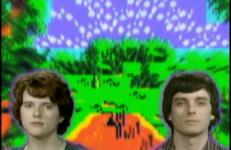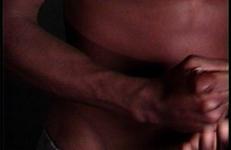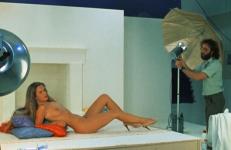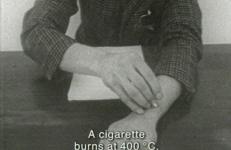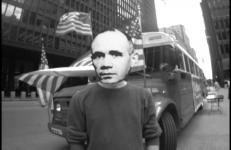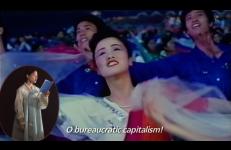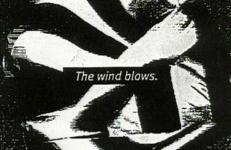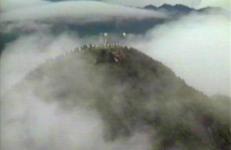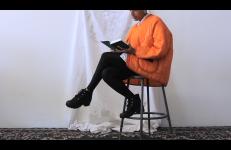In an interview I did earlier this year for the Milan Game Video/Art exhibition, I deflected a question about the connection between Hymn of Reckoning and Reckoning 3, discouraging the idea that there was much of a link between the two videos, apart from their names and their use of video game material. Now that I’ve thought about it more, I can tease out more connections.
Politics
A formidable collage of striking images, this powerful and provocative work confronts racial violence through images of ecological mayhem, machismo, pornography, and Third World poverty — images which return to the taboo body of a black man. "Directed and produced by our culture," An I for An I studies how violence is internalized and psychologized by overlapping soundtracks, printed texts, recurrent images, doctored footage and split screens. The piece attacks racist culture and pleads for an alternative recourse to violence.
I Have Always Been A Dreamer is an essay film about globalization and urban ecology using the examples of two cities in contrasting states of development: Dubai, UAE and Detroit, U.S.A. Within the context of a boom and bust economy, the film questions the collective ideologies that shape the physical landscape and impact local communities.
"Four days spent in a studio working on a centerfold photo for Playboy magazine provided the subject matter for my film. The magazine itself deals with culture, cars, a certain lifestyle. Maybe all those trappings are only there to cover up the naked woman. Maybe it's like with a paper-doll. The naked woman in the middle is a sun around which a system revolves: of culture, of business, of living!
In the Queen City is a series of three videos shot in Buffalo, New York that were produced following an invitation from Hallwalls Contemporary Art Center as part of their Ways In Being Gay festival.
An episode of The Brenda and Glennda Show, hosted by Brenda Sexual and Glennda Orgasm. Production Support Provided by Hallwalls Contemporary Art Center.
In the Queen City is a series of three videos shot in Buffalo, New York that were produced following an invitation from Hallwalls Contemporary Art Center as part of their Ways In Being Gay festival.
An episode of The Brenda and Glennda Show, hosted by Brenda Sexual and Glennda Orgasm. Production Support Provided by Hallwalls Contemporary Art Center.
In the Queen City is a series of three videos shot in Buffalo, New York that were produced following an invitation from Hallwalls Contemporary Art Center as part of their Ways In Being Gay festival.
An episode of The Brenda and Glennda Show, hosted by Brenda Sexual and Glennda Orgasm. Production Support Provided by Hallwalls Contemporary Art Center.
"When we show you pictures of napalm victims, you'll shut your eyes. You'll close your eyes to the pictures. Then you'll close them to the memory. And then you'll close your eyes to the facts." These words are spoken at the beginning of this agitprop film that can be viewed as a unique and remarkable development. Farocki refrains from making any sort of emotional appeal. His point of departure is the following: "When napalm is burning, it is too late to extinguish it. You have to fight napalm where it is produced: in the factories."
A chilling and revealing look at bureaucratic techno-speak, Finley provides a course in “official” media rhetoric, presenting terms and decoding for the audience (i.e. "soft target = city”, “involuntary conversion = crash”) against a slow-motion collage of military imagery. This intensely visual video illustrates how the urban environment has become the site of tactical language, rendering our daily lives in a science-fiction state of constant fear. The visual elements create a rhythm of threat that is punctuated by high altitude shots of military jets.
Found-footage video that addresses American racism and the violence that it spawns.
It's not my memory of it is a documentary about secrecy, memory, and documents. Mobilizing specific historical records as memories which flash up in moments of danger, the video addresses the expansion and intensification of secrecy practices in the current climate of heightened security. A former CIA source recounts his disappearance through shredded classified documents that were painstakingly reassembled by radical fundamentalist students in Iran in 1979.
It's not my memory of it is a documentary about secrecy, memory, and documents. Mobilizing specific historical records as memories which flash up in moments of danger, the video addresses the expansion and intensification of secrecy practices in the current climate of heightened security. A former CIA source recounts his disappearance through shredded classified documents that were painstakingly reassembled by radical fundamentalist students in Iran in 1979.
Alfredo Jaar is a politically motivated artist whose work includes installation, photography and film. Born in Chile and now living in the U.S., Jaar’s socio-critical installations explore global political issues, frequently focusing on the Third World and the relationship between consumption and power. A 1988 installation in a subway station in New York involved dramatic photographs of impoverished gold miners n Brazil interspersed with quotations of current gold prices, drawing an unexpected parallel between the material desires that motivate people in both poverty-stricken Br
A queer rewriting of the events surrounding the 1968 National Democratic Convention in Chicago from the point of view of French writer Jean Genet. Along the way Genet will meet, amongst others, Allen Ginsberg, William S. Burroughs, the Yippies, the Black Panther Party and the Chicago police force... Ultimately, the video is about the difficulty of aligning political and sexual desires.
In the late 1960s Kim Jong Il guaranteed his succession as the Dear Leader of North Korea by adapting his father's Juche (pronounced choo-CHAY) philosophy to propaganda, film and art. Translated as self-reliance, Juche is a hybrid of Confucian and authoritarian Stalinist Pseudo-socialism. The film is about a South Korean video artist who comes to a North Korean art residency to help bring Juche cinema into the 21st Century.
Through a process of degeneration of both sound and image, Just endows the iconic American flag with new context and implication. The image is repeated by generations, using different processes such as digital video, computer printout and photocopying, and then combined with degenerated sound. Single frames of original digital images are exported, and evolve through the repetition of process, before being metamorphosed back to digital image by scanning and rendering.
An experimental documentary about resistance, balance and fame. Kings of the Sky follows tightrope artist Adil Hoxur as he and his troupe tour China’s Taklamakan desert amongst the Uyghurs, a Turkic Muslim people seeking religious and political autonomy.
In this interview, Phyllis Kornfeld, author of Cellblock Visions: Prison Art in America, describes her initial interest in working with prisoners in her native Oklahoma City, stemmed from an exploration of outsider artists. Detailing her first visit to a high security prison as a ‘mind blowing and breathtaking’ experience, Kornfeld discusses how she came to her realization that prisons are fertile environments for free form experimentation with the teaching process. She learned that through personalized art education, inmates could teach themselves to make positive contributions to society. - Kyle Riley
At nineteen, Barbara Kruger (b. 1945) worked as a commercial artist designing for Conde Nast. The risky combination of contemporary art, commercial appeal and social critique runs throughout Kruger’s photography, readings, poetry, collages, and conversation. Her works uses advertising both as a foil and a format. Language and image work together, referencing the manipulations of the advertising media.
Steve Kurtz is a founding member of the Critical Art Ensemble and Associate Professor of Art at University of Buffalo. His areas of focus are contemporary art history and theory as well as post-studio practices. As a student Kurtz collaborated with Steve Barnes on low-tech videos, which they developed into a broad-based artist and activist collective known as the Critical Art Ensemble.
Interview by Gregg Bordowitz.
A historical interview originally recorded in 1999 and re-edited in 2005.
In this video, Glennda Orgasm and Jackie Offie attend Lollapalooza '95 on Randall's Island, New York. Glennda and Jackie sing punk rock songs on the drag stage, and Glennda challenges Courtney Love to a fistfight. The video also shows other performances on the stage, and features Bruce LaBruce's music video for The Riverdales' Fun Tonight.
During a conference in the late 1970s, Carol Leigh (also known as the Scarlot Harlot) coined the term “sex worker.” Now, it is a fundamental part of the lexicon regarding all worker’s rights and this is owed in large part to Leigh’s artistic and activist career. Working primarily through the medium of performance and video – her work attempts to educate and broaden audiences’ understanding of sex work and the fundamental rights sex workers deserve. This interview is a distillation of those aims.
In this video, Brenda and Glennda attend and interview participants at the 1991 New York City Pride March. Speaking with a range of attendees, they underscore the significance of non-white queer communities, diverse gender and sexual identities, and political causes at pride events.
At the Lesbian Museum, Brenda and Glennda interview artists at the opening of Christine Martin’s controversial exhibition The Lesbian Museum: 10,000 Years of Penis Envy at Franklin Furnace. For the exhibition, each artist (including Brenda and Glennda) were given a dildo and asked to turn it into a work of art. The phallus, Freudian philosophy, and female criminality are discussed as a way of analyzing lesbian identity.
Sections 1-30 of an incomplete extended poem describing the artist's connection to the radical black tradition. The completed poem will be formed of 180 sections.
"Lessons are all about constraints; they are thirty seconds, must feature a black figure, and I have rules about where to make cuts, how to edit sound, etc."
— Martine Syms in conversation with Aram Moshayedi, Mousse Magazine




